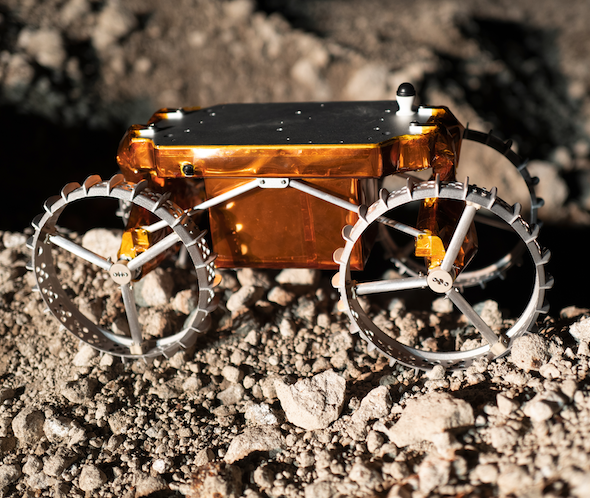NASA Receives First Lunar CubeRover from Astrobotic
Article submitted by Astrobotic
After three years of intensive engineering work, Astrobotic’s CubeRover is on its way to Kennedy Space Center. The CubeRover is designed to provide an affordable mobile outlet for scientific instruments and other payloads to operate on the surface of the Moon. This occasion marks the first time Astrobotic’s Planetary Mobility department has delivered rover hardware to an outside entity.
 Named for its modular, scalable design, the CubeRover was co-developed with Carnegie Mellon University, with input from the NASA Kennedy Space Center, and marks the completion of work on NASA’s $750,000 SBIR Phase 2 contract to develop a lightweight rover with flight characteristics.
Named for its modular, scalable design, the CubeRover was co-developed with Carnegie Mellon University, with input from the NASA Kennedy Space Center, and marks the completion of work on NASA’s $750,000 SBIR Phase 2 contract to develop a lightweight rover with flight characteristics.
Astrobotic has since refined and commercialized the CubeRover product line with the goal of supporting mobility as a service with a variety of diverse payloads, making lunar access easier for smaller tech demonstrations and scientific investigations. The rover is also designed to be integrated onto multiple lunar landers for voyages to the Moon, facilitating its inclusion on a wide variety of future space missions.
Designing the compact CubeRover presented an array of engineering challenges for the Astrobotic and Carnegie Mellon teams. Among many concerns, the teams were tasked with regulating the rover's temperature in extreme climate fluctuations, keeping its mass minimal, and ensuring the rover maintained optimum mobility for instruments operating on the rover. The teams created a robust thermal design able to endure temperatures ranging from space (-455ºF) to the lunar surface (260ºF). The result is the lightest commercial planetary rover ever created. The CubeRover was also outfitted with a calibrated camera used to orient itself relative to known objects on the lunar surface, such as Astrobotic’s Peregrine lander. The ability for the rover's operation team to recognize its position on the Moon augments the value of the data, allowing payload customers to make informed decisions about where to travel next.
“Because our CubeRover is so light — in the four kilogram range — it dramatically reduces flight cost, making the Moon more accessible to more customers,“ says Mike Provenzano, Astrobotic’s Director of Planetary Mobility. "“We’re also including industry standard interfaces throughout the rover to simplify the payload integration process.”
In the coming months, the Kennedy Space Center will conduct a battery of mobility tests on the CubeRover in their analogous lunar regolith simulant — a terrain that closely mimics the surface of the Moon. These tests will measure the slopes, gaps, and other surface irregularities the rover can navigate. Drop testing will ensure the rover is not at risk of tipping over during its deployment from a lander to the lunar surface.
Astrobotic’s work on CubeRover will continue through its $2M Tipping Point contract with NASA, concluding in February 2022. This program funds the flight qualification of the 2U CubeRover product line, and also outfits the rover with a set of advanced features including a lighter all-wheel-drive system, a solar array for recharging, adaptive image compression, and additional interfaces to support a wider variety of landers and payloads.
About Astrobotic
Astrobotic Technology, Inc. is a space robotics company making space accessible to the world. They develop advanced navigation, operation, and computing systems for spacecraft, and their fleet of lunar landers and rovers deliver payloads to the Moon for companies, governments, universities, non-profits, and individuals. The company has more than 50 prior and ongoing NASA and commercial technology contracts and a corporate sponsorship with DHL. Astrobotic was founded in 2007 and is headquartered in Pittsburgh, PA.